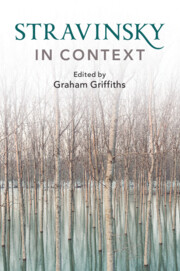Book contents
- Stravinsky in Context
- Composers in Context
- Stravinsky in Context
- Copyright page
- Contents
- Illustrations
- Contributors
- Preface
- Abbreviations
- Frontispiece
- Epigraph
- Part I Russia and Identity
- Part II Stravinsky and Europe
- Part III Partnerships and Authorship
- Chapter 12 Stravinsky’s Sphere of Influence: Paris and Beyond
- Chapter 13 Stravinsky and His Literary Collaborators
- Chapter 14 Assuming Co-authorship: Stravinsky and His ‘Ghostwriters’
- Chapter 15 Nadia Boulanger and Stravinsky: The Transition to America
- Chapter 16 Conversations with Craft
- Part IV Performance and Performers
- Part V Aesthetics and Politics
- Part VI Reception and Legacy
- Recommendations for Further Reading and Research
- Index
- Endmatter
Chapter 12 - Stravinsky’s Sphere of Influence: Paris and Beyond
from Part III - Partnerships and Authorship
Published online by Cambridge University Press: 03 December 2020
- Stravinsky in Context
- Composers in Context
- Stravinsky in Context
- Copyright page
- Contents
- Illustrations
- Contributors
- Preface
- Abbreviations
- Frontispiece
- Epigraph
- Part I Russia and Identity
- Part II Stravinsky and Europe
- Part III Partnerships and Authorship
- Chapter 12 Stravinsky’s Sphere of Influence: Paris and Beyond
- Chapter 13 Stravinsky and His Literary Collaborators
- Chapter 14 Assuming Co-authorship: Stravinsky and His ‘Ghostwriters’
- Chapter 15 Nadia Boulanger and Stravinsky: The Transition to America
- Chapter 16 Conversations with Craft
- Part IV Performance and Performers
- Part V Aesthetics and Politics
- Part VI Reception and Legacy
- Recommendations for Further Reading and Research
- Index
- Endmatter
Summary
Paris in the 1920s experienced one of the most exciting times in its history. Europe was recovering from World War I and the Parisian intelligentsia demanded, and expected, new approaches to music and other art forms. This richly creative decade, known as les années folles (literally ‘the crazy years’), witnessed the convergence of several artistic movements, some in decline, others in ascendance – including Post-Impressionism, Fauvism, Cubism and Surrealism. The musical scene continued to enjoy performances of the Ballets Russes as well as the emergence of the Montparnasse composers who became known as Les Six. To say that Stravinsky found himself in the right place and at the right time would be a great understatement. His encounter with Sergei Diaghilev a decade earlier in St Petersburg had brought him much success, projecting him to the forefront of the Parisian avant-garde scene. The two men first met in February 1909 at the premiere of Stravinsky’s Scherzo fantastique and Feu d’artifice (Fireworks), both composed in 1908. Diaghilev attended this concert at a time when he was making plans to present evenings of Russian opera and ballet in Paris. He was deeply impressed by Stravinsky’s music and it was then that he commissioned the young composer to write a full-length ballet score, The Firebird (1910). Stravinsky became an overnight sensation after the work’s premiere in Paris, which resulted in two subsequent ballet commissions, Petrushka (1911) and The Rite of Spring (1913).1 By the 1920s Stravinsky enjoyed a comfortable life which he divided between France and Switzerland.2
- Type
- Chapter
- Information
- Stravinsky in Context , pp. 109 - 116Publisher: Cambridge University PressPrint publication year: 2020

